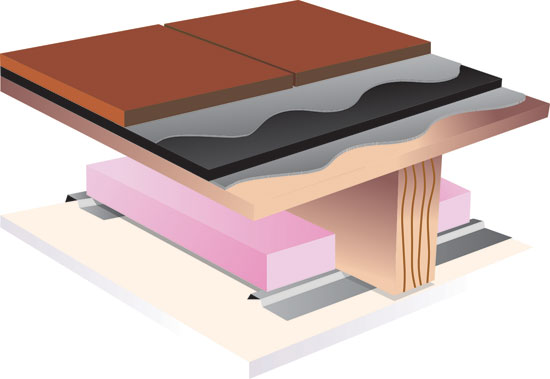Controlling Sound Transmission in Multifamily, Healthcare and Educational Environments
Interior Room Acoustics vs. Transmitted Sound
The basic mechanics of sound that have just been described explain only part of the picture that building designers need to see. When a person speaks (or a radio or television blares), the sound is carried through the air. In buildings, however, there are also structure-borne sounds caused by direct impacts against the structure, such as doors slamming or people walking or jumping on floors. Depending on the building type, these structure-borne vibrations can be very intense. Equipment, machinery, high-volume traffic, rolling gurneys in a hospital, or basketball practice next to a classroom or library all impart vibrations that must be controlled.
There are two primary areas of architectural acoustics that address methods of controlling both air-borne and structure-borne sound transmission.
1) Interior room acoustics
2) Sound transmission
Interior Room Acoustics
Interior room acoustics addresses airborne-sounds that are reflected back from the walls, ceilings, and floors. In this case, designers are most concerned with controlling reverberation (the energy reflected and re-reflected in an enclosed space). Controlling room acoustics happens at the surfaces, beginning with finish materials and furnishings that either absorb or reflect sound, depending on their acoustic qualities. Rooms with very hard surfaces—such as concrete floors, tiled walls, and decorative tin ceilings—reflect a lot of sound. A room with these finishes would be considered “acoustically live,” which may or may not be desirable. Some restaurants and retail centers like an active, busy ambience, whereas in an office or dorm room this acoustic emphasis would be inappropriate. To create a quieter ambience, designers need to select finish materials that absorb sound, such as carpet, acoustic ceiling tile, or perhaps thick fabric wall coverings.
To take room acoustics to a higher level, designers might also wish to control the direction and quality of the reflected sound waves. A lecture hall or performance space will need a variety of engineered baffles and surface textures to deliberately direct, diffuse, and distribute the sound waves within the space. Acoustic design for large performance spaces can get quite involved and is beyond the scope of this course. For now, it's enough to understand that interior room acoustics are primarily controlled by the material properties of interior finish materials. The chief emphasis is on limiting and controlling reflected sound waves.
Sound transmission is another animal altogether. To control the sound and vibrations that are transmitted through building materials from one space to the next, the focus should be on dampening vibrations that pass through building materials, and isolating one room from another by installing absorptive, isolating, and resilient materials within the building assemblies.
Sound Transmission
Sound transmission depends on the partition types. A thick concrete slab, for example, is unlikely to vibrate from individual foot falls, but the impact of heavy equipment or machinery, or even the multiple impacts of a stadium audience, can transfer a significant vibrational load. In a residential multifamily building—one with uninsulated steel joists supporting hardwood floors and standard fire-rated drywall ceilings—foot traffic and perhaps even voices (or radio, television, etc.) will readily transfer to surrounding neighbors.
To control both interior room acoustics and sound transmission in buildings, it helps to understand some basic terms and definitions. In particular, designers need to understand the existing standards for evaluating the acoustical properties of building assemblies and materials.
 |
In the assembly shown here, the key materials are the black recycled rubber underlayment, the pink fiberglass insulation, and the resilient channel. The underlayment and resilient channel isolate structural members, minimizing structure-borne sound, while the fiberglass insulation provides absorption to minimize airborne sound. Illustration courtesy of ECOSilence |
Sound Pressure Levels
Loudness is a subjective measurement, but sound pressure can be quantified in decibels (dB), which is a logarithmic unit: Each increase of 3 is twice as powerful although humans generally perceive an increase of 10 dB as being twice as loud. Ninety dB sounds twice as loud as 80, which sounds twice as loud as 70, etc. See below for a table that correlates subjective interpretations of loudness with sound levels expressed in decibels, providing loudness in dB of some common noise sources.
 |
Loudness is a subjective measure, but sound pressure can be measured quantitatively in decibels. The table above correlates subjective interpretations of loudness to measured decibel levels. |









